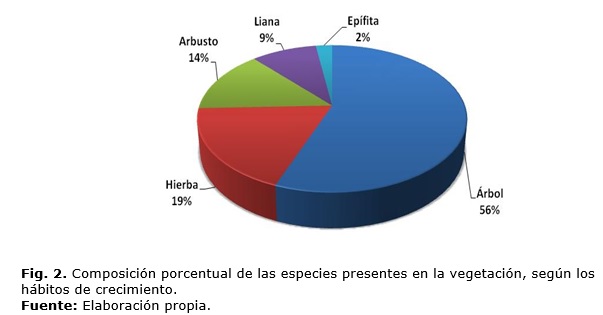Vegetation structure in the mountain forest in the Turquino National Park, province of Granma
Main Article Content
Abstract
Downloads
Article Details
References
ACEVEDO RODRÍGUEZ, P. y STRONG T, T. M. Catalogue of Seed Plants of the West Indies. Washington D.C: Sminthonian Scholarly Press, 2012.
ÁLVAREZ, R. A. Estadística Multivariada y no paramétrica con SPSS. Madrid: Ediciones Díaz De Santos, S.A., 1995.
BERAZAÍN ITURRALDE, R.; ARECES BERAZAÍN, F.; LAZCANO LARA, J. C. y GONZÁLEZ TORRES, L. R. Lista roja de la flora vascular cubana. Gijón: Ayuntamiento de Gijón y Jardín Botánico Atlántico de Gijón, 2005.
BISSE, J. Árboles de Cuba. La Habana: Científico Técnica, 1988.
BUSSMANN, R. W. Los bosques montanos de la Reserva Biológica San Francisco (Zamora- Chinchipe, Ecuador) zonación de la vegetación y regeneración natural. Lyonia, 2003, 3(1), 57-72.
CITMA. Estrategia Ambiental Nacional 2007/2010. La Habana, 2007.
CRONQUIST, A. Na integrated system of classification of flowering plants. New York: Columbia University Press, 1981.
DEL RISCO RODRÍGUEZ, E. Los bosques de Cuba. Su historia y Características. La Habana: Científico Técnica, 1998.
DUTRA SARAÍVA, D. Composição e estrutura de uma floresta ribeirinha no sul do Brasil. Biotemas, 2011, 24 (4), 49-58.
FREDERICKSEN, T. S.; CONTRERAS, F. y PARIONA, W. Guía de silvicultura para bosques tropicales de Bolivia. Proyecto BOLFOR, Santa Cruz, Bolivia, 2001.
HECHAVARRÍA KINDELÁN, O.; ÁLVAREZ BRITO, A. R. y MONTALVO, J. M. Respuesta fenológica de Juglans jamaicensis subsp. jamaicensis al aumento de la temperatura en Bosque Pluvial Montano. Revista Baracoa, 2008, 27 (2), 81 89.
HOMEIER, J.; ENGLERT, F.; LEUSCHNER, Ch.; WEIGELT, P. y UNGER, M. Factors controlling the abundance of lianas along an altitudinal transect of tropical forests in Ecuador. Forest Ecology and Management, 2010, (259), 1399 1405.
LAMPRECHT, H. Silvicultura en los Trópicos. Los ecosistemas forestales en los bosques tropicales y sus especies arbóreas posibilidades y métodos para un aprovechamiento sostenido. Berlín: Cooperación Técnica. República Federal de Alemania, 1990.
LASTRES AGUILAR, I.; HERNÁNDEZ RODRÍGUEZ, P. y GÓMEZ TORRES, J. M. Área Protegida Parque Nacional Turquino. Plan de Manejo 2011-2015, 2011.
LEIVA SÁNCHEZ, A. et.al. Flora de la República de Cuba. En: Serie A. Plantas Vasculares. Fascículo 6 Gentianaceae, Juglandaceae, Phytolaccaceae y Sapotaceae. Köningstein: Koeltz Scientific Books, 2002.
LÓPEZ, P. I. El estado de conservación de Juglans jamaicensis C. DC. En Cuba: evaluación de las subespecies jamaicensis e insularis. Revista Jardín Botánico Nacional, 2000, 21 (1), 149 151.
MAGURRAN, A. E. Diversidad ecológica y su medición. Vedrá: España, 1989.
MCCUNE, B. y MEFFORD M. J. Multivariate analysis of ecological data. PcOrd-Versión 4.17 MjM Sofware. Glennneden Beach, Oregon, USA, 1999.
MORENO, C. E. Métodos para medir la biodiversidad. M &TManuales y Tesis SEA, 1, 2001.
REYES, O. J. Clasificación de la vegetación de la Región Oriental de Cuba. Revista del Jardín Botánico Nacional, 2012, 32-33; 59-71.
SÁNCHEZ, C. Los helechos y licófitas de Cuba. Colombia: Científico Técnica, 2007.
SCHAARSCHMIDTH, H. Flora de la República de Cuba. En Fascículo 6 (2) Juglandaceae. Königstein: Koeltz Scientific Book, 2002.
TIMILSINA, D.; ROSS, M. S. y HEINEN, J. T. A community analysis of sal (Shorea robusta) forests in the western Terai of Nepal. Forest Ecology and Management, 2007, (241), 223-234.


